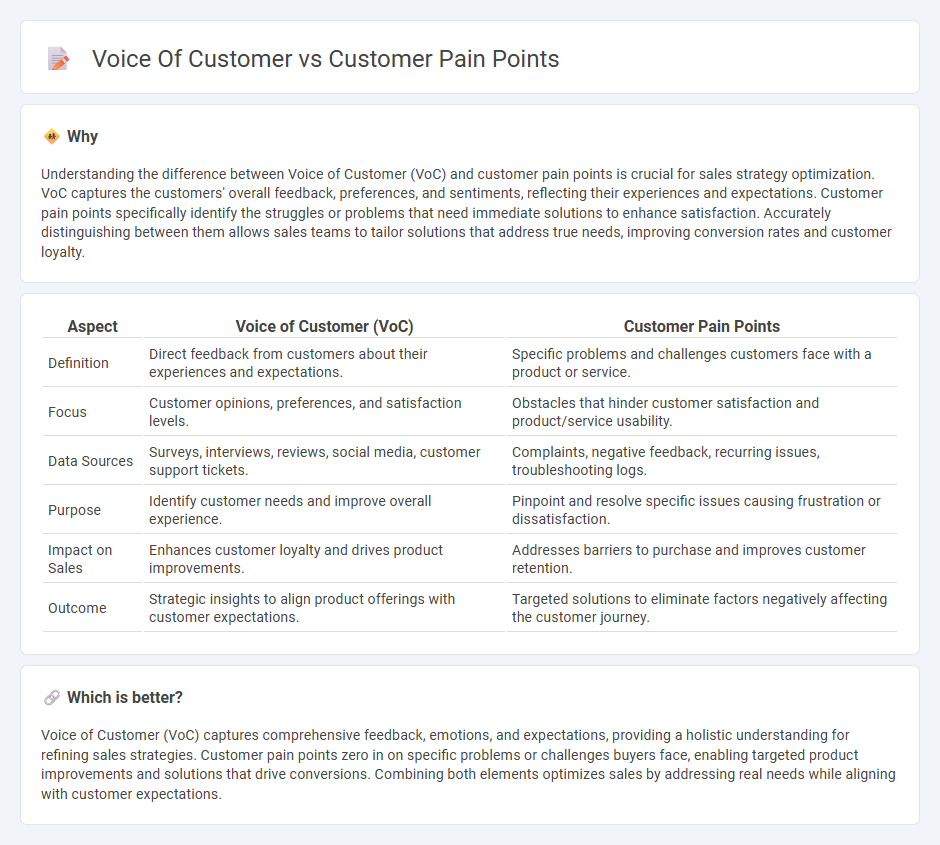
Understanding the voice of the customer reveals authentic feedback and expectations that drive sales strategies. Identifying customer pain points highlights specific challenges and frustrations that hinder purchasing decisions. Explore deeper insights to enhance sales performance and customer satisfaction.
Why it is important
Understanding the difference between Voice of Customer (VoC) and customer pain points is crucial for sales strategy optimization. VoC captures the customers' overall feedback, preferences, and sentiments, reflecting their experiences and expectations. Customer pain points specifically identify the struggles or problems that need immediate solutions to enhance satisfaction. Accurately distinguishing between them allows sales teams to tailor solutions that address true needs, improving conversion rates and customer loyalty.
Comparison Table
| Aspect | Voice of Customer (VoC) | Customer Pain Points |
|---|---|---|
| Definition | Direct feedback from customers about their experiences and expectations. | Specific problems and challenges customers face with a product or service. |
| Focus | Customer opinions, preferences, and satisfaction levels. | Obstacles that hinder customer satisfaction and product/service usability. |
| Data Sources | Surveys, interviews, reviews, social media, customer support tickets. | Complaints, negative feedback, recurring issues, troubleshooting logs. |
| Purpose | Identify customer needs and improve overall experience. | Pinpoint and resolve specific issues causing frustration or dissatisfaction. |
| Impact on Sales | Enhances customer loyalty and drives product improvements. | Addresses barriers to purchase and improves customer retention. |
| Outcome | Strategic insights to align product offerings with customer expectations. | Targeted solutions to eliminate factors negatively affecting the customer journey. |
Which is better?
Voice of Customer (VoC) captures comprehensive feedback, emotions, and expectations, providing a holistic understanding for refining sales strategies. Customer pain points zero in on specific problems or challenges buyers face, enabling targeted product improvements and solutions that drive conversions. Combining both elements optimizes sales by addressing real needs while aligning with customer expectations.
Connection
Voice of customer (VoC) directly captures customer pain points by collecting authentic feedback, revealing specific challenges and unmet needs. Analyzing VoC data enables businesses to identify patterns in customer pain points, informing product improvements and tailored sales strategies. Addressing these pain points enhances customer satisfaction and drives higher conversion rates in sales.
Key Terms
Needs Assessment
Customer pain points highlight specific challenges or problems experienced during product or service use, while Voice of Customer (VoC) captures broader customer feedback, emotions, and expectations throughout their journey. Needs assessment focuses on identifying these pain points and VoC insights to tailor solutions that directly address unmet needs and improve satisfaction. Explore our detailed guide to learn how integrating pain points and VoC enhances your needs assessment process.
Feedback Channels
Customer pain points refer to specific problems and challenges experienced by customers during their interaction with a product or service, often identified through direct complaints or user behavior analysis. Voice of Customer (VoC) encompasses a broader range of feedback collected from multiple channels such as surveys, social media, call centers, and online reviews to capture customer sentiments and expectations comprehensively. Explore more about optimizing feedback channels to effectively address pain points and enhance customer experience.
Solution Alignment
Customer pain points identify specific problems and challenges faced by users, highlighting areas needing improvement. Voice of Customer (VoC) captures detailed feedback and expectations directly from customers, providing insights into desires and priorities. Explore how aligning solutions with these inputs enhances product strategy and customer satisfaction.
Source and External Links
Top 20 Customer Pain Points with Examples & Solutions | Giva - Key customer pain points include long waiting times and poor customer service, causing frustration and dissatisfaction; solutions involve queue management and staff training.
Customer Pain Points: 4 Examples and How To Eliminate Them - The four main types of customer pain points are productivity, support, financial, and process pain points, each affecting customer satisfaction by slowing time, limiting help, increasing costs, or complicating workflows.
Customer Pain Points: Identifying And Resolving Them - SmartSurvey - Customer pain points fall into process, financial, support, and product categories, including issues like complicated sales, hidden fees, slow support response, and inadequate product features.
 dowidth.com
dowidth.com